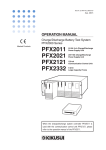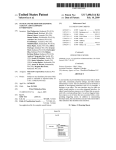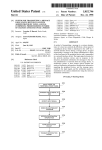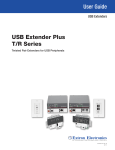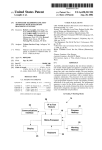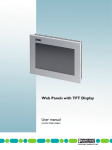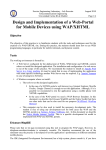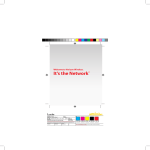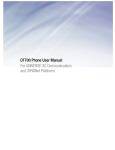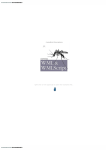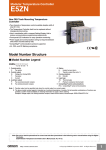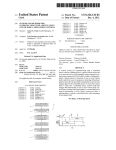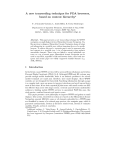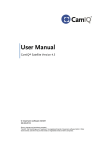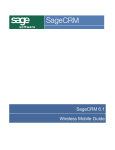Download Method and apparatus for sharing wireless content
Transcript
US007653744B2 (12) Ulllted States Patent (10) Patent N0.: Kanefsky et a]. (54) US 7,653,744 B2 (45) Date of Patent: Jan. 26, 2010 METHOD AND APPARATUS FOR SHARING 6,170,014 B1* 1/2001 Darago et a1. ............. .. 709/229 WIRELESS CONTENT 6,185,535 B1 * 2/2001 6,334,056 B1* 12/2001 Hedin et al. .... .. 704/270 Holmes et al. ............ .. 455/445 (75) Inventors: Steven T. Kanefsky, Redmond, WA (US); Michael Kocheisen, Menlo Park, _ CA (U S); David P. Kormann, (comlnued) Mom'stown, NJ (Us); Bernard 5' FOREIGN PATENT DOCUMENTS Renger, New Providence, NJ (US) GB 2 341 759 A 3/2000 (73) Assignee: AT&T Mobility II LLC, Atlanta, GA (Us) OTHER PUBLICATIONS ( * ) Notice: Subject to any disclaimer, the term of this _ _ Marketing U S C 154(1)) b 2160 da S mobileiwireless/eXpert/PIT20000305S0005/1 Printed out on Dec. ' ' ' y y ' material http://www.planetit.com/techcenters/docs/ 7, 2000. (21) Appl. No.: 09/801,635 (22) Filed: _ patent is extended Or adjusted under 35 (Continued) Mar. 9, 2001 Primary ExamineriTammy T Nguyen (74) Attorney, Agent, or FirmiWoodcock Washburn LLP (65) (60) Prior Publication Data US 2002/0026500 A1 Feb. 28, 2002 (57) Related US. Application Data Provisional application No. 60/21 1 089 ?led on Jun. Embodiments of the invention allow the convenient transmis Sion OfURLS or Content Corresponding to URLs from a WAP/ 12 2000 ’ ' i-mode-enabled mobile device to any other device across a network. In an embodiment, a URL corresponding to content ’ (51) Int CL (52) G0 6F 15/16 U 5 Cl 58 F, M f Cl ' ' ( ) 1e ’ ABSTRACT accessed by WAP/i-mode-enabled mobile device is transmit (200601) 709045 709029 709017 ' """"""""""" " 0 ,? t, s ’ 455/44 h 370/338’ ’7 09/2 4 5 21551753012171 2623c 4 5 5 /4 4 5’ See application ?le for complete search history. ( 56 ) ted to an application server. The WAP/i-mode-enabled mobile device further transmits a destination address for the content to the application server. The application server then trans mits the URL corresponding to the content to the destination address. The URL can then be used to render the correspond mg Content at the desnnanon address References Cited In another embodiment, a URL corres P onding to content accessed by the WAP/i-mode-enabled mobile device is trans U-S~ PATENT DOCUMENTS 5 061 738 A * 5,812,776 A * 5,870,549 A 5,895,471 A mitted to an application server. The WAP/i-mode-enabled 10/1991 Solomon et a1‘ __________ __ 523/100 9/1998 Gifford ..................... .. 709/217 21999 Bobo H 4/ 1999 King ’et al‘ 6,061,738 A * 5/2000 6,115,611 A 9/2000 Kimoto et al. mobile device further transmits a destination address for the Content to the application 561'" er - The application 561'" er then fetches the content corresponding to the URL and transmits the content to the destination device. Osaku et a1. .............. .. 709/245 42 Claims, 3 Drawing Sheets 10 20 S S WAP/IMODE ENABLED MOBILE MOBILE DEVICE DEVICE 40 WIRELESS NETWORK 30 APPLICATION SERVER 50 DEVICE US 7,653,744 B2 Page 2 Wireless Application Protocol Push Architectural Overview, Version 08iNov. 1999, Wireless Application Protocol Forum, Ltd. 24 pp., US. PATENT DOCUMENTS 6,356,905 B1 * 6,594,347 B1* 3/2002 7/2003 Gershman et al. ........... .. 707/10 Calder et al. .... .. 379/88.01 6,661,784 B1* 12/2003 Nykanen 6,711,156 B1* 3/2004 370/338 Gourraud .................. .. 370/352 XP-002155620. Wireless Application Protocol Wireless Application Environment Overview Version 1.3, WAP-195-WAE Overview, Verson 29iMar. 2000, Wireless Application Protocol Forum, Ltd. 23 pp., XP-002155622. OTHER PUBLICATIONS Unwired Planet, Inc; UP.SDK Getting Started Guide, version 3.1 for HDML; Jan. 19, 1999, pp. 1-32, Redwood City, CA., USA. Leavitt, Neal, Will WAP Deliver the Wireless Internet?, Technology News, pp. 16-20, May 2000, XP000948629. * cited by examiner US. Patent Jan. 26, 2010 US 7,653,744 B2 Sheet 1 0f 3 FIG. 1 40 1o 20 s s WAP/IMODE ENABLED MOBILE MOBILE DEVICE DEVICE WIRELESS NETWORK APPLICATION SERVER 50@@ DEVICE US. Patent Jan. 26, 2010 Sheet 2 of3 US 7,653,744 B2 FI G. 2 WAP/IMODE ENABLED APPLICATION DESTINATION MOBILE DEVICE sERvER DEVICE FEATURE SET GUI s w SELECT 21° 20° OPTION COMMAND ‘ (SEND URL OR URL CONTENT“ 220 w 23° ENTER ADDRESS ADDRESS S 4 E 240 250’ APPLICATION SERVER ACTION APPLICATION SERVER TRANSMISSIONA S 260 FI G. 3 0L 1w sAvE BOOKMARK 2w SEND BOOKMARK FI G. 3 b w SEND URL bwSEND URL CONTENT E US. Patent Jan. 26, 2010 Sheet 3 of3 US 7,653,744 B2 FIG. 4 APPLICATION SERVER 250 w DESTINATION DEVICE CACHE/ PROCESS CONTENT CORRESPONDING TO URL SEND POINTER TO CACHED/ PROCESSED CONTENT‘ S 260 FIG. 5 APPLICATION SERVER DESTINATION DEVICE 250w CACHE/PROCESS CONTENT CORRESPONDING TO URL SEND CONTENT THAT WAS CACHED/PROCESSED ‘ S , 260 FIG. 6 550 s e10 A 620 s MEMORY 54o PORT ~ PROCESSOR — s INSTRUCTIONS US 7,653,744 B2 1 2 METHOD AND APPARATUS FOR SHARING WIRELESS CONTENT ties of HTML (e.g., rendering tables and frames) have been left out of cHTML. Thus, cHTML alloWs i-mode Web pages to doWnload more quickly to mobile devices running an i-mode microbroWser (“i-mode-enabled device”). CROSS-REFERENCE TO RELATED APPLICATIONS Because i-mode Web sites are Written using versions of HTML, such sites can also be accessed and rendered by devices running ordinary Internet broWsers. This contrasts With the situation for WAP Web sites, Which cannot be ren This application claims priority from US. Provisional Application Ser. No. 60/211,089, ?led on Jun. 12, 2000, Which is incorporated by reference herein. dered by devices running ordinary Internet broWsers. When a user of an i-mode-enabled device bookmarks a BACKGROUND OF THE INVENTION Web page, the title of the Web page becomes the title of the bookmark. Because i-mode Was originally designed foruse in The present invention relates to the ?eld of transmission of content, and more particularly relates to the ?eld of the trans mission of content from mobile devices to other devices through a network. The increasing use of mobile devices connected to each other and other devices through netWorks has led to searches for solutions to problems associated With communication betWeen these devices. One type of common mobile device Japan, i-mode-enabled devices (including the microbroWser for such devices) display Japanese text, although English text is also supported. The i-mode service uses S-JIS character encoding, GIF formatted images, and half-Width kana char acters. The microbroWsers usually have a title bar With icons at the top of a LCD screen. The user can manipulate the icons to access various services.A text screen beloW the title bar can 20 employs the Wireless Application Protocol (“WAP”) to alloW The term “WAP/i-mode-enabled device” Will be used to denote a device that is WAP-enabled and/ or i-mode-enabled. From this point on, the term “deck” Will be used to denote a WAP deck, and/ or an i-mode Web page. The term “card” Will the communication of information to and from the mobile device. The WAP is a secure protocol that alloWs users real-time access to information using handheld Wireless devices, 25 including mobile phones, pagers, tWo-Way radios, smart phones and other devices. WAP supports most Wireless net 30 systems (e.g., PalmOS, EPOC, WindoWs CE, FLEXOS, OS/9, and JavaOS). WAP devices having displays and access to the Internet run microbroWsers Which are broWsers having small ?le siZes that are able to operate under the loW memory constraints of handheld devices and the loW-bandWidth constraints of most content on a WAP/i-mode-enabled device requires that the user transmit the URL corresponding to displayed content to another user Within a message. If an e-mail message Were used to transmit the URL, the user Would have to manually 35 type the URL into the e-mail message using the micro broWser. In addition to expending effort in having to manually enter the URL, the user generally is not able to observe the content corresponding to the URL and manually enter the URL at the same time. Also, by composing a message for manual entry of the URL, the user Will have had to access Wireless netWorks supporting handheld devices. The Wireless Markup Language (“WML”), Which has been specially cre ated for small screens and navigation Without a keyboard, is the markup language for WAP. be used to denote an atomic unit of displayable information in WAP and/or i-mode. One de?ciency of WAP/i-mode-enabled devices is that they do not alloW for a convenient Way of sharing content With other devices on the netWork. One knoWn method for sharing Works, including CDPD, CDMA, GSM, PDC, PHS, TDMA, FLEX, ReFLEX, iDEN, TETRA, DECT, DataTAC, and Mobitex. WAP is supported by nearly all current operating display text messages and data. WAP also supports WMLScript, Which is a simpli?ed ver sion of JavaScript that minimiZes demands on memory and another URL (i.e., the URL associated With composing e-mail messages) and Will probably no longer see the dis played content for the URL she Wanted to send. Alternatively, the processor. WML and WMLScript together constitute the Wireless Application Environment (“WAE”). In this docu if a voice-mail message Were used to transmit the URL, the user Would have to dictate the URL into the voice-mail mes ment, a device employing a microbroWser and supporting WML and/or WMLScript Will be denoted using the term “WAPenabled device.” 40 45 insertion is inconvenient and dif?cult using a microbroWser. WAP/i-mode-enabled devices do not have any kind of copy and paste capability, so several manual steps Would be needed WML is the analog in WAP of Hypertext Markup Lan guage (“HTML”), Which is used to create and present content on the World Wide Web (“WWW” or “Web”). A WML ?le, Which is analogous to a Web page in HTML, is structured as 50 to transmit the URL or the URL content shoWn on the device. Additionally, even if the URL corresponding to content displayed on a WAP/i-mode-enabled device is transmitted in this manner, the recipient Will only be able to access the most current content corresponding to the URL, because the con a “deck” of one or more “cards”. A card corresponds to an atomic unit of displayable information in WML. A WML ?le (i.e., a deck) is referenced using a Uniform Resource Locator (“URL”), similar to the Way HTML ?les (e. g., Web pages) are sage. Other media for transmitting the URL also require the user to manually insert the URL into a message. Such manual 55 referenced. The user interface for WML is created using a tent may be changed by the entity controlling the Web site corresponding to the URL. For example, if the content corre deck of cards. WML also includes methods for implementing sponding to the URL is updated or changed during the period access control for content. beginning With the time that the URL is sent in a message by the user of the WAP/i-mode-enabled device and ending With the time the recipient accesses the URL, then the recipient Will access content different from that originally intended to be transmitted by the user of the WAP/i-mode-enabled device. In many cases, the user may desire that the recipient The NTT DoCoMo i-mode is another protocol that alloWs users real-time access to information using handheld Wireless 60 devices, including mobile phones, pagers, tWo-Way radios, smartphones and other devices. The NTT DoCoMo i-mode “i-mode”) service is not based on WAP; instead of WML, i-mode uses a simpli?ed version of HTML called Compact HTML (“cHTML”). cHTML is actually a subset of HTML that is intended for devices With sloWer connection speeds, like mobile devices. In particular, the resource intensive abili vieW the same content that the user vieWs at a given instant of 65 time. The Excite service (on the Internet at WWW.excite.com) has a WAP portal that alloWs WAP-enabled devices to access US 7,653,744 B2 3 4 various content sources including general neWs, business neWs, sports neWs, etc. The Excite QuickCut feature allows users of WAP-enabled devices to send messages including content in WML cards or decks to multiple e-mail addresses. other device across a netWork. In an embodiment, a URL abled mobile device is transmitted to an application server. The WAP/i-mode-enabled mobile device further transmits a However, the Excite QuickCut feature requires modi?cation destination address to the application server. The application of the WML card or deck to include a QuickCut link at the bottom of the WML card or deck. Thus, for the user to be able to send content corresponding to a URL using the Excite server then transmits the URL corresponding to the content to the destination address. The URL can then be used to render the corresponding content at the destination address. In another embodiment, the content corresponding to a URL may be transmitted instead of the URL. corresponding to content accessed by the WAP/i-mode-en QuickCut feature, the content corresponding to the content must have been modi?ed to include the QuickCut feature. Because this modi?cation must be done for each and every URL for Which the corresponding content is desired to be sent, this method is cumbersome and inadequate. Further more, the Excite QuickCut feature does not alloW the trans 1. System and Components FIG. 1 illustrates a system suitable for use With embodi ments of the present invention. In FIG. 1, WAP/i-mode-en abled mobile device 10, mobile device 20 and application mission of the URL (as opposed to the content corresponding server 3 0 are connected to Wireless netWork 40. WAP/i-mode enabled mobile device 10 may be a mobile device that runs a to the URL) or a modi?ed URL. Thus, there is a need for a convenient method for sharing microbroWser and that supports WML, WMLScript and/or content displayed on a WAP/i-mode-enabled device With other devices across a netWork. Further, this method should cHTML. Mobile device 20 may be any device that is capable of Wireless communication on netWork 40, including a device that implements WAP and/or i-mode. Wireless netWork 40 is be independent of and separate from the content applications 20 a netWork that is capable of carrying Wireless communica vieWed on the WAP/i-mode-enabled device; i.e., the method for transmitting content corresponding to a deck should not require modi?cation of the deck to enable the functionality of transmitting the corresponding content. Moreover, there is a need for ensuring that the content accessed by the recipient is tions over its nodes. 25 the same as that intended to be shared by the transmitter. SUMMARY OF THE INVENTION Embodiments of the invention alloW the transmission of netWork 50. In particular, application server 30 may perform relaying services by communicating messages to and from 30 content from a WAP/i-mode-enabled mobile device to any other device across a netWork. In one embodiment, an indi cation of a URL corresponding to content accessed by a WAP/i-mode-enabled mobile device is received. Addition ally, a destination address is received from the WAP/i-mode enabled mobile device. Subsequently, an indication of the URL corresponding to the content is transmitted to the des tination address. BRIEF DESCRIPTION OF THE DRAWINGS Application server 30 runs WAP and/or i-mode applica tions that enable at least some of the functionality of mobile devices 10 and 20. For example, application server 30 may act as a gateWay for mobile devices that are part of Wireless netWork 40 in reaching services on another netWork, e. g., devices attached to Wireless netWork 40 through netWork 50. Application server 30 may further perform services in con nection With translation from communication protocols used 35 in connection With Wireless netWork 40 to translation proto cols used in connection With netWork 50 and vice versa. For example, if netWork 50 is the Internet, application server 30 may be capable of translating communications received from Wireless netWork 40 in WAP and/or i-mode into communica tions utiliZing protocols associated With the World Wide Web (e.g., Hypertext Transfer Protocol), and vice versa. Applica 40 tion server 30 may be a Web server, or be capable of the functionality of a Web server; for example, application server FIG. 1 is a block diagram of a system in accordance With 30 may be capable of executing Common GateWay Interface the present invention. FIG. 2 shoWs a How diagram of an embodiment of the present invention in Which a URL or content corresponding to a URL is sent from a WAP/i-mode-enabled mobile telephone. 45 FIG. 3-a shoWs an example of a GUI on a WAP/i-mode enabled mobile device that displays the bookmarking func tionality options. FIG. 3-b shoWs an example of a GUI on a WAP/i-mode 50 enabled mobile device that displays further bookmarking cation server 30. Application server 30 may also run applica tions in connection With functionality relating to Wireless functionality options. FIG. 4 shoWs a section of the How diagram of an embodi ment of the present invention in Which a modi?ed URL is received by a destination device from a WAP/i-mode-enabled mobile device. FIG. 5 shoWs a section of the How diagram of an embodi ment of the present invention in Which content or modi?ed content corresponding to a URL is received by a destination device from a WAP/i-mode-enabled mobile device. FIG. 6 shoWs a computer-readable medium embodiment of (“CGI”) script, and thus alloW a user to interact dynamically With a Web server (not shoWn). Alternatively, or additionally, application server 30 may be capable of running servlets to Which a user device may pass data using appropriate servlet script calls. For the purposes of this document, an “invoking script call” shall refer to either a CGI script call, or a servlet script call that is used by a user device to pass data to appli 55 netWork 40 of mobile devices attached to Wireless netWork 40. For example, application server 30 may run a bookmark application that alloWs the user of a WAP/i-mode-enabled netWork device like WAP/i-mode-enabled mobile device 10 to store desired URLs as bookmarks that may be accessed at a later time. Such a bookmark application can be controlled 60 by the user of WAP/i-mode-enabled mobile device 10 through a graphical user interface (“GUI”) displayed on WAP/i-mode-enabled mobile device 10. NetWork 50 may be the Internet, an Intranet, or any other netWork capable of carrying netWork communications. the present invention. Device 60 is a device attached to netWork 50 that is capable of receiving and/or transmitting communications through net DETAILED DESCRIPTION OF THE INVENTION Embodiments of the invention alloW the transmission of Work 50. For example, if netWork 50 is the Internet, device 60 may be a personal computer connected to the Internet. Any content from a WAP/i-mode-enabled mobile device to any device connected to either Wireless netWork 40 or netWork 50 65 US 7,653,744 B2 5 6 Will have a network address that enables it to communicate With other devices connected to Wireless network 40 and/or tion server. The command may also include information iden tifying the URL, such as text containing the URL or a pointer to the URL. In step 230, the user of the WAP/i-mode-enabled device enters the netWork address of the user (i.e., the destination address of a destination device corresponding to such user) to Whom the URL or content corresponding to the URL is to be netWork 50. For example, the netWork address of mobile device 20 may be a Wireless telephone number, Whereas the netWork address of device 60 may be an e-mail address, a URL, an IP address, or an instant messaging address, if net Work 50 is the Internet. 2. OvervieW of Certain Embodiments of the Invention Embodiments of the invention alloW the convenient trans sent. The user may enter or select the destination address after being prompted to do so by the GUI displayed on the WAP/ i-mode-enabled device. In step 240, the destination address is transmitted from the mission of a URL or content corresponding to a URL from a WAP/i-mode-enabled mobile device to any other device across a netWork. In the embodiments discussed beloW, a WAP/i-mode-enabled device to the application server. The URL corresponding to content accessed by the WAP/i-mode destination address may, for example, be the number for another mobile phone, an e-mail address, a facsimile number, enabled mobile device is transmitted to an application server. The WAP/i-mode-enabled mobile device further transmits a destination address for the content to the application server. In a ?rst embodiment, the application server then transmits the URL corresponding to the content to the destination address. The URL can then be used to render the correspond ing content at the destination address. In a second embodiment, the application server fetches the content corresponding to the URL and stores it in a cache for subsequent retrieval. The application server further creates a modi?ed URL that effectively acts as a pointer to the data stored in the cache. The application server then transmits the modi?ed URL corresponding to the neWly-created deck or Web page to the destination device. In a sub-embodiment, the application server may modify the content corresponding to the original URL received from the WAP/i-mode-enabled device and cache the modi?ed content. In a third embodiment, the application server fetches the content corresponding to the URL and stores it in a cache for subsequent retrieval. The application server then transmits an instant messaging address, an IP address, or any other netWork address (e. g., a phone number corresponding to Short Message Service). In step 250, the application server may take further action 20 For example, the application server may fetch and cache the content corresponding to the URL. The application server may also modify the content by, for example, adding adver tising to the cached content, or by translating the content 25 corresponding to the URL into a form that can be rendered on 30 the destination device. In step 260, the application server transmits the URL, a modi?ed URL, or the content corresponding to the URL to the destination device. Embodiments of the invention alloW the transmission of a URL or content corresponding to a URL Without requiring any modi?cation to enable the transmission functionality. In particular, embodiments of the invention (unlike the Excite QuickCut service) do not require the addition of a link in this content to the destination device. In a sub-embodiment, the application server may modify the content corresponding 35 ing to a URL may be transmitted in embodiments of the invention Without any pre-processing required to enable the transmission functionality. HoWever, as part of the transmis execution in embodiments of the invention. In step 200, code 40 part of the process of transmission (as opposed to a step needing to be performed before the transmission), and is not “required” to enable the transmission; i.e., it is an optional feature that alloWs, for example, the insertion of advertising in connection With the transmission. Embodiments of the invention, especially embodiments 50 bookmark application options shoWn in FIG. 3-11. The GUI on 55 including an option for sending a URL and an option for sending content corresponding to a URL, as shoWn in FIG. 3-19. The user may then specify Whether the URL, or Whether content corresponding to the URL, is to be sent, by selecting from one of these options. In step 220, a command corresponding to the user’s selected option is transmitted from the WAP/i-mode-enabled device to the application server. For example, assuming the user has selected in step 210 the option corresponding to the sion of a URL or content corresponding to a URL, the URL or content corresponding to a URL may be modi?ed (e.g., to add advertising to the URL as described beloW). Such modi?ca tion in embodiments of the present invention is performed as corresponding to the transmission of a URL or content cor responding to a URL to another user. For example, the user may select the “send bookmar ” option from among the the WAP/i-mode-enabled device may then display options content that is desired to be transmitted to enable the trans mission functionality. Thus, any URL or content correspond to the URL received from the WAP/i-mode-enabled device and cache the modi?ed content. FIG. 2 shoWs a How diagram for data How and process or content for a feature set corresponding to options displayed on the WAP/i-mode-enabled device is transmitted from the application server to the WAP/i-mode-enabled device. For example, a WAP and/ or i-mode card containing options that can be selected by the user of the WAP/i-mode-enabled device may be transmitted from the application server and displayed on the WAP/i-mode-enabled device. In step 210, the user of the WAP/i-mode-enabled device may select one of the options that Were transmitted from the application server and displayed on the WAP/i-mode-enabled device in step 200. In particular, the user may select an option in connection With the request to transmit the URL or the content corresponding to the URL to the destination address. 60 corresponding to variations in steps 250 and 260, are dis cussed in further detail beloW. 3. The Bookmark Application and its Use in an Embodi ment of the Invention An enhanced bookmark application that runs on applica tion server 30 may be used in embodiments of the invention. The enhanced bookmark application alloWs the transmission of URLs and/ or content corresponding to transmitted URLs, in addition to the bookmarking of URLs. Thus, by modifying the bookmark application program running on the application server, the functionality of mobile devices is greatly enhanced. The bookmark application normally operates by display ing, in response to a user request, a GUI on WAP/i-mode enabled mobile device 10 prompting the user to choose transmission of a URL or content corresponding to a URL to 65 Whether a displayed URL should be saved as a bookmark. If another user, a command requesting the application server to the user chooses to save the URL as a bookmark, WAP/i transmit the URL to another user may be sent to the applica mode-enabled mobile device 10 composes a message con US 7,653,744 B2 7 8 taining the URL associated With application server 30 together With the URL to be saved appended as an argument. the user’ s list of stored addresses, or may display an interface for manual entry of a netWork address. The user may then select or enter the netWork address of the location to Which she desires the URL be sent. In response, mobile device 10 may transmit the destination netWork address to the book WAP/i-mode-enabled mobile device 10 transmits the mes sage, Which is received by application server 30. The book mark application, running on application server 30, then saves the URL transmitted as an argument in a list uniquely mark application, Which may store the address together With associated With WAP/i-mode-enabled mobile device 10. Additional information in connection With the saved URL can also be transmitted by the user and stored in the list uniquely associated With WAP/i-mode-enabled mobile device 10 in a the URL that Was received earlier. Subsequently, the book mark application may transmit the URL to the netWork address received from the user. By selecting the URL dis played on the destination device, the user of the destination device may vieW the content corresponding to the transmitted URL. Thus, in this embodiment, a URL corresponding to content that is being accessed on WAP/i-mode-enabled mobile device 10 is transmitted to either another WAP/i-mode-enabled similar manner. The bookmark application itself may be a WAP and/or i-mode construct in that the source code for the bookmark application may be Written using WML, WMLScript, and/or cHTML. In this case, the options displayed on the GUI of WAP/i-mode-enabled mobile device 10 correspond to decks containing content that the user may access by selecting. The bookmark application can be modi?ed such that the options shoWn in FIG. 3-a are displayed on mobile device 10 in response to an input by the user corresponding to a request for use of the bookmarking service. In an implementation in Which the bookmark application is a WAP and/or i-mode construct, each option line displayed on mobile device 10 and shoWn in FIG. 3-a may correspond to a deck that may be accessed by a selection of the user of mobile device 10. device, or to a device that is connected to another netWork (e.g., the Internet). Accordingly, as shoWn in step 220 of FIG. 2, a command is received from the user device that the user Wishes to transmit 20 in response to an input from the user, mobile device 10 may transmit a command to an application server at a remote location in the netWork for transmitting the currently-ac 25 If the user selects the “save bookmar ” option, the URL in the user’s area for favorite URLs. For example, if the user URL as CGI script arguments in a call (or, more generally, in is currently accessing the URL: Then the user’s selecting the “save bookmark” option may result in the bookmark application on the home deck being called. The currently-accessed URL and TITLE of the URL can be passed as CGI script arguments (or, more generally, in an invoking script call) appended to the call to the bookmark an invoking script call) to the bookmark application running 30 35 application: device:home/bookmark?URL:http://test.com/ test.hdml&TITLE:Testing&Option:save As shoWn in the example above, the CGI script argument may 40 also include an indicator that the “save bookmar ” option is used (using the statement “Option:save”); additional options that are further described beloW may also be passed in the CGI script argument in a similar fashion. The bookmark application running on the server may then receive the 45 appended argument and store the corresponding URL in the storage area for the user’s favorite URLs. If the user selects the “send bookmark” option shoWn in FIG. 3-a, then the options shoWn in FIG. 3-b may be dis played on the WAP/i-mode-enabled mobile device. By select ing the “send URL” option, the user may cause a URL accessed by the user of the WAP/i-mode-enabled mobile device to be transmitted to a destination device. By selecting the “send URL content” option, the user may cause content corresponding to a URL accessed by the user of the WAP/i mode-enabled mobile device to be transmitted to a destina 50 55 In step 260, the URL is transmitted from the application be subsequently connected. The user of the destination device may click on the displayed URL, Which may cause the des tination device to display the corresponding content. 5. An Embodiment of the Invention in Which Modi?ed URLs are Transmitted 60 In a second embodiment, a modi?ed URL may be trans mitted to the destination device by the application server instead of the original URL received by the application server option. The URL may be sent to the bookmark application in from the WAP/i-mode-enabled device (i.e., the original URL). The application server may send the modi?ed URL, the same manner as that discussed above in connection With special location for further transmission. The bookmark application may then cause mobile device 10 to display either may display the user’s stored address book for selection of a target destination, or may display a GUI for the user’s manual input of an address for transmission of the URL. The user may either select a destination address for transmission of the URL from the address book, or may manually type an address into the GUI of mobile device 10 for transmission. Further, the destination address for transmission of the URL is trans mitted to and received by the application server. For example, the destination address may be sent by mobile device 10 as a CGI script argument in a call to the bookmark application. The destination address may, for example, be the number for another mobile telephone, an e-mail address, a facsimile number, an instant messaging address, an IP address, or any other netWork address. tion device that the user can select and to Which the user can the currently-accessed URL by selecting the “send URL” the “save bookmar ” option, With the exception that the book mark application may save the URL that Was passed in a on the application server. The bookmark application may parse the received CGI script arguments, extract the URL, and store the extracted URL in temporary storage for further transmission. In step 230, the user is prompted for a destination address for transmission of the URL. For example, mobile device 10 server to the destination address received in step 240. For example, the URL may be displayed as a link on the destina tion device. Both of these options are described in greater detail beloW. 4. An Embodiment of the Invention for Sending URLs In a ?rst embodiment of the invention, the user may send cessed URL. Additionally, the URL that the user Wishes to transmit is received from the user device. For example, the user device may transmit the selected option (e.g., using the statement “Option:sendurl”) and the currently-accessed that is currently-accessed by mobile device 10 may be saved http://test.com/test.hdml the currently-accessed URL to another location. For example, 65 for example, to ensure that the destination device vieWs con tent corresponding to the original URL together With adver tising inserted by the application server, or to ensure that the US 7,653,744 B2 10 destination device is sent content in a format suitable for Alternatively, the application server may form a connec tion With the destination device and determine the appropriate rendering on the destination device. In a ?rst sub-embodiment, once the destination address and format for rendering of content on the destination device based on the properties of the connection With the destination device. The application server may then translate the content into a form that can be rendered by the destination device and cache such formatted content. Thus, in this second embodiment, the application server at step 250 of FIG. 2 (and FIG. 4) may take additional action as described above. For example, the application server may cache the content corresponding to the original URL, or may cache a modi?ed version of the content corresponding to the the URL to be transmitted to the destination address are received, the application server creates a neW URL (neW deck or Web page) that contains a link pointing to the transmitted URL or modi?es an existing URL (existing deck or Web page) to contain a link to the transmitted URL. Further, the appli cation server may insert advertising into this deck; for example, the message: “this page Was forWarded to you cour tesy ofAT&T Wireless Services” may be inserted. The appli cation server may then transmit the URL corresponding to this neWly-created (or neWly-modi?ed) deck to the destina original URL (e.g., by adding advertising and/or translating tion address. The user of the destination device may select the URL of the neW (or modi?ed) deck to display the deck con taining the link to the transmitted URL. The user of the destination device may then access the content corresponding to the URL sent by mobile device 10 as Well as the inserted the content into an appropriate format for rendering on the destination device). The application server may further create a neW deck or Web page that points to the cached content (or may modify an existing one to point to the cached content.) advertisements, by selecting the displayed link. Thus, the ?rst may transmit the URL for the neWly-created (or neWly-modi sub-embodiment is a tWo-step process, because the user of the destination device needs to select a URL (to a neW or existing The application server at step 260 of FIG. 2 (and FIG. 4) 20 the destination device that the user can select and to Which the user can be subsequently connected. The content of the deck deck) in order to display the deck that contains another URL (or link). The user of the destination device then selects this link in order to access the content associated With the trans mitted URL. In a second sub-embodiment, the application server, after receiving the original URL or a pointer to the original URL from the WAP/i-mode-enabled mobile device, may fetch the content corresponding to the received URL from the netWork. The application server may then cache the fetched content. The application server may further create a neW deck (or Web 25 Some destination addresses, for example, facsimile and/or 30 35 modi?ed) deck to the destination address. The user of the destination device may then access the content corresponding to the original URL by selecting the displayed URL. Thus, the the second sub-embodiment, for example, by inserting adver created or neWly-modi?ed deck that is displayed on the des tination device, may thus access the modi?ed content. The application server may also modify the content corre transmission of a URL. 45 The user of mobile device 10 may signal her desire to transmit content displayed on mobile device 10 by, for example, selecting the option “send URL content” shoWn on FIG. 3-!) from the bookmark option list displayed on mobile device 10. Mobile device 10 may transmit the selected option (e.g., by including the statement "Option:sendurlcontent” in an invoking script call), the URL corresponding to the dis played content, and the destination address to the application 50 sponding to the original URL by translating or reformatting the content such that it can be correctly rendered on the destination device. The application server may then cache such modi?ed content. The user of the destination device, sponding to the content. Furthermore, the user of mobile device 10 may Wish to directly transmit content displayed on mobile device 10, Whether or not the destination device is capable of rendering content corresponding to a URL. In such cases, content displayed on WAP/i-mode-enabled mobile device 10 may be sent to the destination device through the application server, in a manner similar to that disclosed for the 40 the transmitted URL. The application server may modify the cached content in tising into the content corresponding to the original URL and by caching such modi?ed content. The user of the destination device, after selecting the URL corresponding to the neWly based on a transmitted URL. For such destination addresses, content displayed at mobile device 10 may have to be trans mitted directly, rather than indirectly, using the URL corre the cached content. The application server may then transmit second sub-embodiment is a one-step process, because the user of the destination device selects a single URL (to a neW or existing deck) in order to access the content associated With (including any advertising) can be displayed on the destina tion device. 6. An Embodiment of the Invention in Which Content is Transmitted e-mail addresses, do not alloW the direct retrieval of content page) or modify a pre-existing deck (or Web page) so that the neWly-created or neWly-modi?ed deck includes or points to the URL corresponding to this neWly-created (or neWly ?ed) deck or Web page to the destination address received in step 240. For example, this URL may be displayed as a link on server in the manner disclosed earlier. In response, the appli cation server may fetch the corresponding content and then transmit this content to the destination device for rendering. The application server, before transmitting the content to the destination device, may also modify the content corre sponding to the received URL by translating or reformatting after selecting the URL corresponding to the neWly-created or neWly-modi?ed deck that is displayed on the destination the content such that it can be correctly rendered on the destination device. The user of the destination device may thus access modi?ed content that can be correctly rendered on device, may thus access the modi?ed content. The application server may determine the correct format or the destination device. protocol for translation of the content based on its knoWledge of the destination device. For example, the application server may determine based on previous transactions With the des tination device or through lookup in an appropriate database, the characteristics of the destination device. The application 55 The application server may determine the correct format or 60 protocol for translation of the content based on its knoWledge of the destination device. For example, the application server may determine the characteristics of the destination device based on previous transactions With the destination device, or through lookup in an appropriate database. The application server may then translate the content into a form that can be 65 server may then translate the content into a form that can be rendered by the destination device and cache such formatted content. rendered by the destination device and cache such formatted content. For example, if the destination address is a computer US 7,653,744 B2 11 12 connected to the Internet and capable of rendering HTML, then HTML-content may be transmitted from the application 8. An Embodiment in Which Content Displayed at a Given Time is Transmitted The content corresponding to a URL may be changed server to the destination address. However, if the destination address is a telephone number corresponding to a facsimile device, the content corresponding to the URL may be trans facsimile transmission, and transmitted using the appropriate during the time interval betWeen the transmission of the URL address by mobile device 10 and the time at Which the user of the destination device invokes the received URL at the desti nation device. Consequently, the content displayed on the facsimile protocol. If the destination address is an e-mail address, the bookmark application may send the content as a on mobile device 10. In many cases, the user of mobile device lated by the application server into a format appropriate for destination device may differ from that originally displayed text attachment to an e-mail message, or may include the content as text in the body of the e-mail. Alternatively, the application server may form a connec 10 Will Want the destination device to display updated ver sions of the content corresponding to the transmitted URL. HoWever, in certain instances, the user of mobile device 10 tion With the destination device and determine the appropriate may Want the recipient to access the exact same content as that format for rendering of content on the destination device based on the properties of the connection With the destination device. The application server may then translate the content into a form that can be rendered by the destination device and cache such formatted content. In yet another alternative, the application server may trans late the content into a plurality of different formats and trans mit the differently-formatted versions to the destination device. Then, the destination device (or the user of the desti originally accessed by the user of mobile device 10. For these cases, an option may be added to the list of options displayed on the user device and shoWn on FIG. 3-!) having, for example, the title, “send URL With state at present time.” If the user selects this option, then the application server may store the content corresponding to the URL at that time in a 20 server may then transmit the URL corresponding to this deck to the destination device. The destination device Would then display this link. The user of the destination device may nation device) may choose from among the differently-for matted versions a proper one for rendering on the destination device. 25 30 35 message or into the attachment for the message. In step 260 of FIG. 2 (or FIG. 5), the application server transmits the message containing the content (or the modi?ed content) to the destination device. The user of the destination device, by accessing the received message, Will thus access the content (or the modi?ed content) corresponding to the URL transmitted from the WAP/i-mode-enabled device to the application server. 7. An Embodiment of the Invention in Which a GateWay 40 be transmitted by the bookmark application in embodiments 45 In an embodiment of the invention, the functionality asso ciated With translation betWeen and among protocols is located in a gateWay that is physically separate from the application server. In this embodiment, When mobile device 50 10 transmits a URL to the application server for transmission to a destination device, the gateWay translates the content associated With the URL into a format that can be rendered by the destination device. The gateWay may determine the cor rect format for the destination device from the destination 55 address, Which is the netWork address of the destination device. For example, the gateWay may determine that a des tination address is a facsimile machine, if the destination address is given as a phone number. Alternatively, the gate of the invention. Such embodiments are Within the scope of the disclosed invention. 10. Embodiments Stored in Computer-readable Medium FIG. 6 illustrates computer-readable medium embodiment of the present invention. In FIG. 6, processor 610 is coupled to port 630 and memory 620. Port 630 may be any type of port used for input or output; in particular, any output of a process executed by processor 610 can be transmitted through port 630. Memory 620 is a computer-readable medium that can store instructions 640 that are adapted to be executed by processor 610. In particular, memory 620 can store instruc tions 640 corresponding to any method embodiments of the present invention. Speci?cally, memory 620 can store instructions 640 corresponding to the method embodiments of the present invention discussed in this disclosure. 11. Applications Other Than the Bookmark Application 60 may be Used in Embodiments An application other than the bookmark application may be used in embodiments of the invention. Any application running on the application server that is capable of displaying addresses and device types. By table lookup in this database, the gateWay may determine that a received destination address corresponds to a device capable of receiving docu ments or images coded using a predetermined format. The gateWay may then translate the content corresponding to the URL into a format supported by the destination device and transmit the translated content to the destination address. other Way of indicating the URL Without explicitly including the URL. Thus, instead of the transmission to the bookmark application of the actual URL corresponding to content dis played on mobile device 10, a pointer pointing to this URL can be transmitted by mobile device 1 0 in embodiments of the invention. Further, instead of the transmission to the destina tion device of an actual URL, a pointer pointing to a URL can Distinct from the Application Server is UtiliZed Way may access a database that contains tables of netWork user transmitted the URL. 9. Embodiments in Which Indications of URLs are Trans mitted In the embodiments discussed above, indications of URLs may be transmitted instead of actual URLs. An indication of a URL may be the actual URL, a pointer to the URL, or any URL into a format that can be correctly rendered on the destination device, and insert this translated content into the receive the original content by selecting, at any time, the displayed link. Thus, the destination device Will display con tent corresponding to that intended to be transmitted by the user of mobile device 10; that is, the content of the URL transmitted by the user of mobile device 10, at the time that In this third embodiment, at step 250 of FIG. 2 (or FIG. 5), the application server fetches the content corresponding to the URL received from the WAP/i-mode-enabled mobile device and creates a message containing the content in the body or as an attachment. At this step, the bookmark appli cation may optionally insert advertising into the message or in an attachment to the message. The bookmark application may further translate the content corresponding to the received neWly-created deck (or in an existing deck). The application user options as decks on mobile device 10 may be used for this 65 purpose. Modi?cations to such applications similar to the modi?cations disclosed above in the context of the bookmark application may be performed to enable the transmission of US 7,653,744 B2 13 14 URLs and corresponding content. Such embodiments are “bookmark” application by selecting the necessary links on Within the scope of the present invention. the WAP/i-mode-enabled device, the user may be given a mitted to a destination device directly from a list of book choice betWeen the “Save Bookmark” option and the “Send Bookmark” option. If the user selected the “Send Bookmark” option, the user is prompted for a destination addresses. marks Without re-accessing the bookmark. The URL may be Before or after the user’ s selection of an option, the user could stored as a bookmark either on the WAP/i-mode-enabled mobile device or on the application server. To transmit a the keypad on the phone) or to select from a list of canned In one embodiment, a URL that has been stored as a book mark (and that had been previously-accessed) may be trans also be prompted to enter a customiZed message (e.g., using previously-accessed bookmark that is saved in the bookmark messages (e.g., from among messages including “call me right aWay” or “thanks”). The message entered or selected by list, the user may select a corresponding option from a menu displayed on the WAP/i-mode-enabled mobile device (using the bookmark vieWing application). The user may select the bookmark for transmission from the list of bookmarks dis played on the device, and may also select an option for trans the user may be transmitted together With the URL or URL mission, such as “send URL” or “send content corresponding to URL”, as described above. The device may then pass the bookmarked URL and the selected option as arguments in an invoking script call to the application server as described above. The URL or the content corresponding to the URL may then be transmitted by the application server to the destination device in the manner described above. Further overall message as discussed above. content, and could be rendered by the destination device together With the transmitted URL or URL content. In a similar fashion, advertisements could be inserted into the 16. Conclusion As described above, the various embodiments of the present invention describe a method and system for transmit ting URLs or content corresponding to URLs displayed on 20 WAP/i-mode-enabled mobile device to any other device con nected to a netWork. Additional bene?ts accruing from more, more than one URL in the bookmark list, or content embodiments of the invention include simply and ef?ciently corresponding to more than one URL in the bookmark list, implementing the sharing of content displayed on a WAP/i may be transmitted by the user’s selection of a plurality of URLs from the URLs residing in the bookmark list. Such modi?cations are Within the scope of the disclosed invention. 12. URLs or Content Corresponding to URLs May be Sent to More Than One User The embodiments described above may be modi?ed to alloW the transmission of URLs or content corresponding to 25 invention alloW the transmission of a URL or content corre sponding to a URL Without requiring any modi?cation to enable the transmission functionality. In particular, embodi 30 tions may be made by those skilled in the art in light of the disclosures herein, and are Within the scope of the embodi The present invention has been described in terms of sev ments of the invention that Were described. 35 from History Stack In embodiments of the invention, a URL (or the URL’s content) may be transmitted to a destination device for URLs 40 history stack, the sending user may access a previously-ac comprising: menu displayed on the WAP/i-mode-enabled mobile device. an argument to the bookmark application as described above. Thus, the embodiments discussed earlier may be modi?ed to send a previously-accessed URL or the content correspond ing to a previously-accessed URL to destination devices. Furthermore, more than one URL in the history stack, or content corresponding to more than one URL in the history stack, may be transmitted by the user’ s selection of a plurality of URLs from the URLs residing in the history stack. Such modi?cations are Within the scope of the disclosed invention. 14. An Embodiment in Which the Application Server Resides in the User Device In an embodiment of the present invention, the application server may reside in the WAP/i -mode-enabled mobile device. In such embodiments, the application server, running on the user device, may perform the functionality of the application What is claimed is: 1. A method for transmitting content, or information related to the content, from a ?rst WAP/i-mode-enabled device to a second WAP/i-mode-enabled device, the method cessed URL by selecting the corresponding option from a Additionally, the previously-accessed URL can be passed as eral embodiments solely for the purpose of illustration. Per sons skilled in the art Will recogniZe from this description that the invention is not limited to the embodiments described, but may be practiced With modi?cations and alterations limited only by the spirit and scope of the appended claims. that have been previously-accessed by the sending user. Such URLs are stored in a history stack either on the WAP/i-mode enabled mobile device or on the application server. Using the ments of the invention do not require the addition of a link in content that is desired to be transmitted to enable the trans mission functionality. Thus, any URL or content correspond ing to a URL may be transmitted Without any pre-processing required to enable the transmission functionality. URLs to more than one destination device. Such modi?ca 13. Sending URLs or Content Corresponding to URLs mode-enabled device using pre-existing features of WAP/i mode-enabled devices. Furthermore, embodiments of the 45 receiving a command from a ?rst WAP/i-mode-enabled 50 device for transmission of a ?rst URL that is accessed by the ?rst device, Wherein the ?rst device has received content associated by the ?rst URL; receiving a destination address for transmission of the ?rst URL, Wherein the destination address is associated With the second device; generating a message including an indication of the second URL, Wherein the second URL corresponds to the con 55 tent received by the ?rst device; and transmitting the message to the destination address, Wherein the message can be used to access the content by the second device associated With the destination address. 2. The method of claim 1 Wherein the ?rst URL and the 60 second URL are identical. 3. The method of claim 1 Wherein the command includes an server described in the embodiments above. Such modi?ca tions are Within the scope of the present invention. invoking script call containing the ?rst URL as an argument. 4. The method of claim 1 Wherein the indication is a pointer 15. Messaging in Connection With Transmission of Con enabled devices to send a URL or content corresponding to a to the second URL, and a ?le associated With the second URL includes a pointer to the ?rst URL. 5. The method of claim 4 Wherein the ?le associated With URL to various destination addresses. After invoking the the second URL contains advertising. tent Embodiments of the invention alloW users of WAP/ i-mode 65 US 7,653,744 B2 16 15 25. The method of claim 24 Wherein the modi?ed version 6. The method of claim 1 wherein the indication is a pointer to the second URL. 7. The method of claim 1 Wherein the indication includes the second URL. 8. The method of claim 1 Wherein the ?rst URL is cur of the content is in a format suitable for rendering on a destination device at the destination address. 26. The method of claim 20 Wherein the ?rst URL is a previously-accessed URL and is retrieved from a history stack prior to the receiving of the command. rently-accessed by the WAP/i-mode-enabled device. 9. The method of claim 1 Wherein the content correspond ing to the ?rst URL is cached. 10. The method of claim 9 Wherein a ?le corresponding to the second URL includes the cached content. 11. The method of claim 9 Wherein a ?le corresponding to 27. The method of claim 20 Wherein the ?rst URL is a previously-accessed URL and is retrieved from a list of book marks prior to the receiving of the command. 28. The method of claim 20 Wherein the WAP/i-mode enabled device is a device that is WAP-enabled, but not i-mode-enabled. 29. The method of claim 20 Wherein the WAP/i-mode enabled device is a device that is i-mode-enabled, but not WAP-enabled. 30. A method for transmitting content, or information related to the content, from a WAP/i-mode-enabled device, the second URL includes a modi?ed version of the cached content. 12. The method of claim 11 Wherein the modi?ed version of the cached content includes advertising. 13. The method of claim 11 Wherein the modi?ed version of the cached content is in a format capable of being rendered on a destination device at the destination address. 14. The method of claim 13 Wherein the format for the modi?ed version of the cached content is selected based on the destination device. 15. The method of claim 1 Wherein the ?rst URL is a previously-accessed URL and is retrieved from a history the method comprising: 20 tent; storing the content for subsequent retrieval; stack prior to the receiving of the command. 16. The method of claim 1 Wherein the ?rst URL is a previously-accessed URL and is retrieved from a list of book 25 marks prior to the receiving of the command. 17. The method of claim 1 Wherein the WAP/i-mode-en abled device is a device that is WAP-enabled, but not i-mode enabled. 18. The method of claim 1 Wherein the WAP/i-mode-en abled device is a device that is i-mode-enabled, but not WAP enabled. 19. A method for transmitting content from a WAP/i-mode enabled device, the method comprising: 30 35 for transmission of a ?rst URL that is accessed by the device; URL; 40 generating a message including an indication of a second URL, a ?le associated With the second URL including a transmitting the message to the destination address. 20. A method for transmitting content from a WAP/i-mode 45 the destination device at the destination address. 36. The method of claim 30 Wherein the URL is a previ ously-accessed URL and is retrieved from a history stack 37. The method of claim 30 Wherein the URL is a previ ously-accessed URL and is retrieved from a list of bookmarks receiving a ?rst URL from a WAP/i-mode-enabled device 50 receiving a destination address for transmission of the ?rst URL; generating a message including a pointer to a second URL, Wherein the pointer, second URL, or both relate to data accessible via the ?rst URL; and transmitting the message to the destination address to per 32. The method of claim 30 Wherein the content is trans lated into a format different from the format of the content rendered on the WAP/i-mode-enabled device, before inclu sion of the content into the message. 33. The method of claim 32 Wherein the format into Which the content is translated can be properly rendered by a desti nation device at the destination address. 34. The method of claim 33 Wherein the format into Which the content is translated is selected based on the destination device at the destination address. 35. The method of claim 34 Wherein the format into Which prior to the receiving of the command. enabled device, the method comprising: in a command including an invoking script call; advertising inserted by an application server. the content is translated is selected based on a connection With modi?ed version of the content corresponding to the ?rst URL; and generating a message including the content; and transmitting the message to the destination address, With out any required pre-processing of the content or the URL to enable the transmission. 31. The method of claim 30 Wherein the content includes receiving a command from a WAP/i-mode-enabled device receiving a destination address for transmission of the ?rst receiving a command from a WAP/i-mode-enabled device for transmission of content corresponding to a URL; receiving a destination address for transmission of the con 55 prior to the receiving of the command. 38. The method of claim 30 Wherein the WAP/i-mode enabled device is a device that is WAP-enabled, but not i-mode-enabled. 39. The method of claim 30 Wherein the WAP/i-mode enabled device is a device that is i-mode-enabled, but not WAP-enabled. mit a device associated With the second address to access 40. A computer-readable medium having stored thereon the data. 21. The method of claim 20 Wherein the ?rst URL and the instructions adapted to be executed by a processor, the second URL are identical. instructions, Which When executed, initiate the transmission 60 22. The method of claim 20 Wherein a ?le associated With the second URL contains a pointer to the ?rst URL. 23. The method of claim 20 Wherein a ?le associated With ond telecommunications device, the instructions including: receiving a command from a WAP/i-mode-enabled device the second URL contains advertising. 24. The method of claim 20 Wherein a ?le associated With the second URL contains a modi?ed version of the content corresponding to the ?rst URL. of content, or information related to the content, from a ?rst WAP/i-mode-enabled telecommunications device to a sec 65 that a URL accessed by the device Will be transmitted, Wherein the URL corresponds to content the ?rst WAP/ i-mode-enabled telecommunications device Wishes to share With the second telecommunications device; US 7,653,744 B2 17 18 receiving a destination address for transmission of the URL to the second telecommunications device, Wherein the destination address is associated With the second tele generating a message including an indication of a second URL, or pointer, to the content; and transmitting the message to the destination address to per mit a device associated With the destination address to communications device; access the stored content. generating a message including an indication of the URL; and transmitting the message to the destination address, instructions adapted to be executed by a processor, the Wherein the mes sage can be used to access the content by instructions, Which When executed, initiate the transmission 42. A computer-readable medium having stored thereon of content, or information related to the content, from a WAP/ the second telecommunications device. i-mode-enabled device, the instructions including: 41. A computer-readable medium having stored thereon receiving a command from a WAP and i-mode-enabled instructions adapted to be executed by a processor, the device, or just i-mode enabled device, for transmission instructions, Which When executed, initiate the transmission of content associated With a URL that is accessed by the of content, or information related to the content, from a WAP/ device; i-mode-enabled device, the instructions including: receiving a destination address for transmission of the URL or the content corresponding to the URL; storing the content, or modi?ed version of the content, for receiving a command from a WAP/i-mode-enabled device for transmission of a ?rst URL that is accessed by the device, Wherein the URL corresponds to content sub sequent retrieval generating a message including the content, or modi?ed version of the content, correspond accessed by the device; receiving a destination address for transmission of the con tent or the ?rst URL; 20 ing to the URL; and transmitting the message to the destination address. storing the content, or revised version of the content, for sub sequent retrieval; * * * * *















